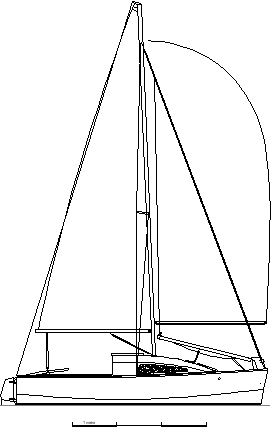
BLUE SKIES
Winner of the 3rd prize in the
'PRACTICAL BOAT OWNER'
design competition, 1999.
(See the December 1999 edition of PBO)
| home | designer profile | send email | purchase plans |
 |
BLUE SKIES is the culmination of 20 years of thought into what is my ideal small trailer-sailer. In the late sixties and early seventies I produced several successful Merlin Rocket designs. Later, I looked around for a 'dinghy with a lid' that I could keep at home, trail anywhere, and provide occasional overnight accommodation. Unfortunately, most boats available at that time were 'pocket cruisers' - little floating caravans with poor performance. I therefore bought a Yachting World Rambler called 'Lively', a 17ft double chine plywood boat designed in 1953 by Jack Holt. I had seen one in the sixties at my local sailing club, where it had literally sailed rings round the local Silhouettes. The half deck version that I bought had a steel plate centreboard of about 40kg. as its only ballast. (Jack had also designed a version with a cabin, which had additional iron ballast). |
I beefed up the centreboard to 70kg, added a small coachroof, moved the centreboard case aft, and redesigned the rig. I squeezed two berths into the cabin. The boat performed really well, and I had many years of fun sailing her, mainly on the East Coast, and often singlehanded. I became amazed by the little boat's abilities in anything up to a force 5-6. In spite of her light ballast I never once put the gunwhale under. 'Lively' gave me much food for thought - but I thought I could do better - much better......
In 1994 I started designing 'Blue Lightning', a trailer-sailer which I built myself and launched in August 1995. She was 6.73 metres LOA, and was as large a boat as I could trail behind my Citroen BX turbo diesel, which had a maximum recommended tow weight of 1100Kg. Her 1995 CHS rating was .965 - significantly faster than the then new Hunter 707 (.935) which was a foot longer! Yes, she was fast - we broad reached off Salcombe in 1997 at 20 knots. But she was also comfortable to sleep aboard; she had excellent manoeuvrability under power, and could be launched and sailed singlehanded. To my knowledge, there is no commercially available equivalent to 'Blue Lightning'. She is a unique trailer-sailer.
But now there is BLUE SKIES
BLUE SKIES is similar in concept to 'Blue Lightning', but is nearer to 'Lively' in size. With this design, I aim to achieve a small boat in a 'modern classic' style, which is practical in every way, yet has timeless good looks and will perform superbly. The design has no gimmicks or eccentricities. Everything about her has been tried and tested over the last 20 years, with my earlier boats. The PBO competition has provided the spur for me to produce this design, which I have had in mind for some time.
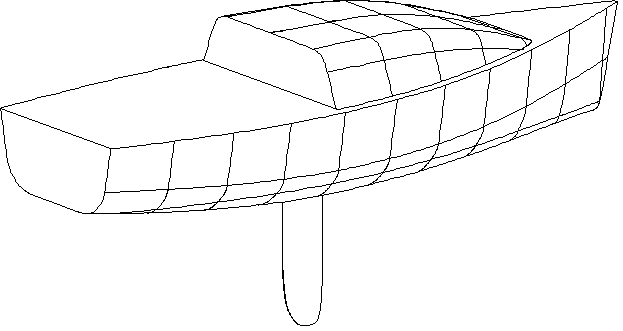
Performance
The dinghy pedigree is clearly evident in the isometric drawings of the hull. Underwater she has little keel rocker, a fine, straight entry with U sections giving way to a long flat aft run (not unlike my later Merlin designs). The boat is clearly designed to plane, but great efforts have been made to retain a hull form that is balanced when heeled up to 30 degrees. Her beam/length ratio of 3.4 is slender by 'pocket cruiser' standards and indicates an easily driven hull, as does the Displacement/Length ratio of 145 - very low for a nineteen footer!
The sail area/displacement ratio of 18.2 and the SA/wetted surface ratio of 2.5 show that she has enough sail to perform well in light airs.
The dinghy shape has another advantage: the form has high initial stability, making her almost as stiff at lower heel angles as boats with much higher ballast ratios.
Ballast of 150kg of lead is incorporated in the lower half of the centreboard. (ballast ratio 17.5%). This gives a low total boat weight - great for towing and great for sailing fast, yet providing sufficient righting moment to give a capsize angle of more than 105 degrees. The stability curve is shown below. In order to provide a realistic curve, the data is calculated using a centre of gravity of the yacht with two crew sitting in the cockpit on the weather side. This has the effect of improving initial stability, but has a negative effect on ultimate stability.
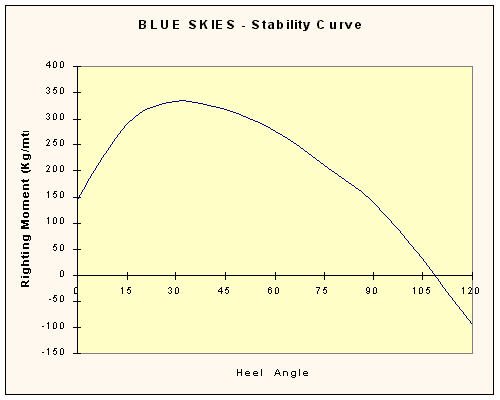
The designed displacement is 860kg, including 2 crew and their gear. Estimated CHS empty weight is 550kg.
BLUE SKIES will be a delight to sail, and will amply reward the enthusiastic sailer.
Construction
I have drawn the lines for two construction methods: strip plank and multi-chine (plywood). The former gives a fairer hull form, and is not much more difficult for the amateur to build than the ply version. It was the method I used for 'Blue Lightning', with 12mm Western Red Cedar strips, glassed both sides. This is what the Gougeon brothers call 'wood/glass/epoxy composite'. It is the more expensive construction method, so to keep costs down 8mm ply is used for the topsides, lapping the ply over the strip planking to provide a visible line which accentuates the fine hull shape. The coachroof is made in a similar way, with the flat top and sides being joined by a curved area made from cedar strips.
A 4cm thick hardwood external keel runs the full length of the hull, and there are bilge keels of similar thickness amidships. All keels have a 1.5cm brass band fitted, as the boat is designed for off-beach use. The keel also helps locate the boat easily on its trailer rollers. The keel is the largest piece of solid timber in the boat (though in 'Blue Lightning' it was actually made in five parts!). The screws used to attach the keelbands are just about the only fastenings used in the hull.
The entire area of strip planking has 1 layer of glass cloth sheathing inside and out, with an additional layer externally below the waterline.
The inside of the hull is stiffened with bulkheads at approximately 60cm intervals, fixed to the hull with epoxy fillets. The arrangement of the cabin and the cockpit provides adequate longitudinal support. Carbon fibre stiffening is provided in the coachroof beams in order to keep them small and light.
The end result is a very stiff yet very light hull, built with relatively 'low tech' methods that can be applied by a competent amateur.
All wood surfaces have 3 coats of epoxy resin applied, followed by 2-part polyurethane paint, which keys very well to the epoxy and provides a very durable finish.
The multi-chine version is just a little easier, cheaper and quicker to build. With the 'stitch and tape' technique and the ability of epoxy resin to fill large gaps and maintain structural integrity, a novice might find this method less intimidating.
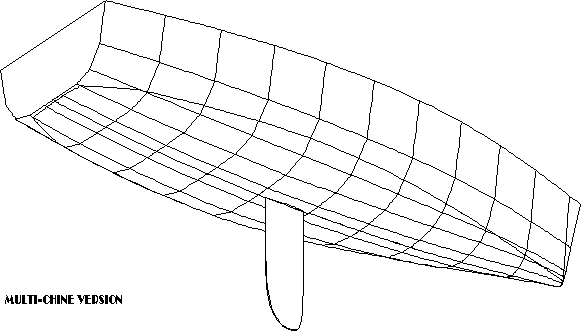
Deck Layout
There is a large anchor well, which provides a safe stowage and handling area, and the necessary depth to allow a vang on the jib boom.
Access to the anchor well is over the coachroof or via the hatch at the forward end of the coachroof.
The coachroof itself extends the full width of the boat, maximising room below. With the self tacking/reefing foresail there is little need to go forward while sailing.
The sliding main hatch is offset to port, to enable access to the cabin at the side of the centreboard case.
The following control lines are led to the aft face of the coachroof:
Thus all controls are easily available for singlehanded use.
The cockpit is large enough for 4 or more, and is long enough to stretch out in (or even sleep in, under a suitable tent). There are acres of locker space. The mainsheet traveller (with jammer) slides on a track situated above the tiller and the outboard.
The outboard is situated in a well on the centreline, just forward of the transom. The motor can be raised and a plug fitted in the well when sailing. This configuration was implemented in 'Blue Lightning' and has proved very successful. The smallest outboard with a F/N/R gearbox will be adequate to drive the hull at near displacement speed (5-6 knots). ('Blue Lightning' has a Yamaha 4ac motor). Fit a 20hp job and turn her into a speedboat! (Extra hull stiffening required!).
The Rig
The mainsail (9.9 sq m) is conventional, with two slab reefs. The foresail (6.45 sq m) is set on a jib boom, which has a vang, and an adjustable clew outhaul.
The boom is controlled by a single sheet on the centreline. With these systems, sail twist and angle can be totally controlled. The boom enables an efficiently wide sheeting angle off the wind, and even automatically goosewings when the wind is aft. (Don't ask me to give an explanation of the dynamics of this, but it works on my two previous boats!). Tacking involves merely putting the helm over.
A foresail roller reefing system is fitted, which, although expensive on this size of boat, makes it possible to sail single handed in the widest range of wind strengths.
A conventional spinnaker is shown on the sailplan. An asymmetric would be sexier, but fast as this boat is, she is not quite fast enough to turn every run into a reach.
Interior Layout
The centreboard case is the major factor in determining the accommodation layout. The centreboard is set well aft in the boat, and similarly the rig is further aft than is usual. I have found that this configuration works well, freeing the bows, and minimising pitching and nosediving. It has the added benefit of allowing the two main berths to be placed forward of the case, and by offsetting the companionway to port, the case in fact gives little obstruction. A removable infill panel converts the forward berths to a large double.
A Porta-potti toilet fits under the companionway step, and on the port side is a small hanging locker and a large insulated built-in ice box, with worktop for a spirit stove. To starboard is a (nearly) full size quarter berth, with removable worktop over part of it, and stowage shelves above that on the forward face of the main bulkhead. There is lots of stowage space under the berths, and sitting headroom with space for five at a pinch. The 12v battery (for single all round white nav light (10w), interior light (8w) and instrument lights (2w) is fitted under the berths forward.
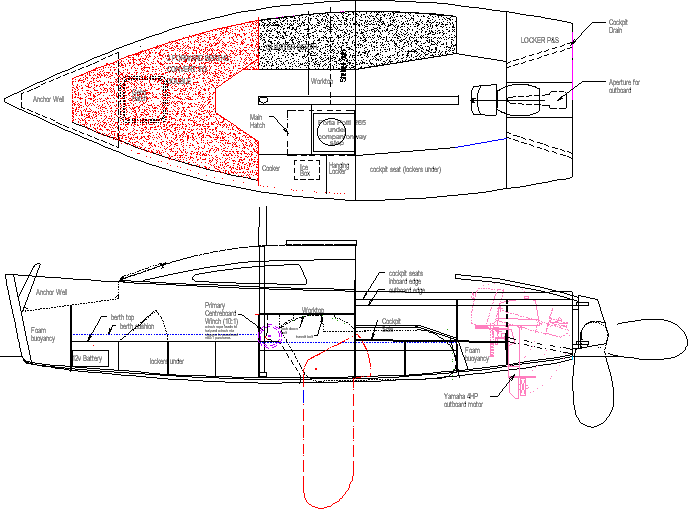
Towing
The all-up towing weight including trailer and cruising gear is estimated at 1050kg. Well within the abilities of most medium family cars, and low enough to require only a 2 wheel trailer.
Launch Procedure
The mast is carried horizontally above the boat, supported by a crutch on the trailer at the tow hitch end and a strut fitted to the rudder fittings at the stern. (The strut also carries the number plate and lights).
Simply slide the mast aft so that the heel aligns with the deck fitting, fit the hinge pin, attach the shrouds, attach the forestay via a rope led back to the cockpit through the anchor roller, and lift.
The rig is probably light enough to raise unaided, but a simple alloy tubular 'A' frame, similar to the one I use on Blue Lightning and costing only a few pounds, could be used. The halyard winch is used to raise the rig.
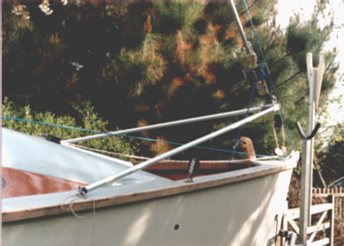
Photo of BLUE LIGHTNING's 'A' frame.
Rig time: 2 hours from arrival on site to launch (realistic - includes loading gear from car, filling water containers, toilet etc).
Safety
No guardrails are fitted on the boat as they would be an obstacle forward (no side decks) and aft (impedes beach use of boat). Safety is maintained by use of crew harnesses attached to points in the cockpit.
12cu ft of foam buoyancy is installed in the bow and under the cockpit. This is sufficient to float the boat with the crew aboard and not immersed above their knees.
If the boat lays over to port with mast horizontal, the offset main hatch stays above the static waterline.
| home | designer profile | send email | purchase plans |
Last Updated 13 March 2004